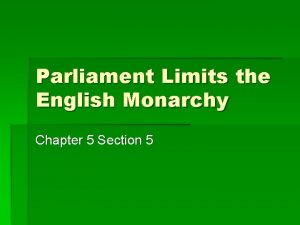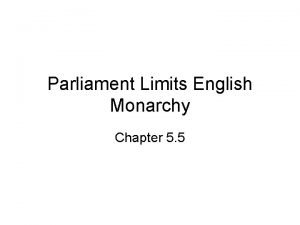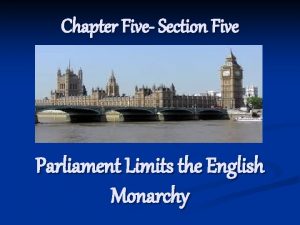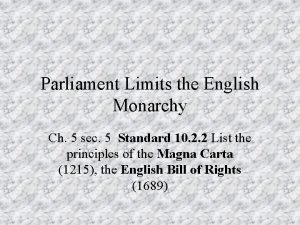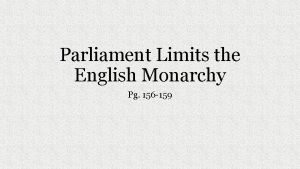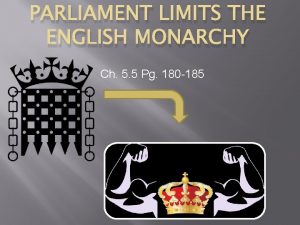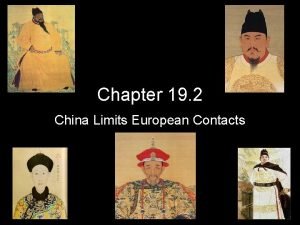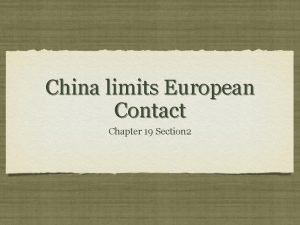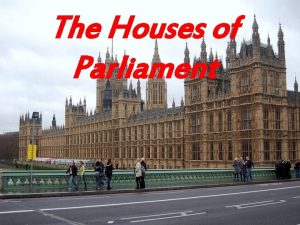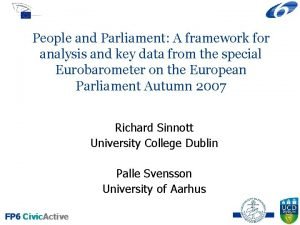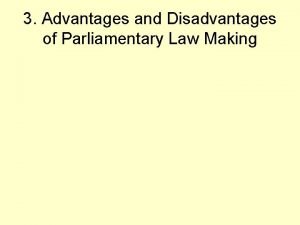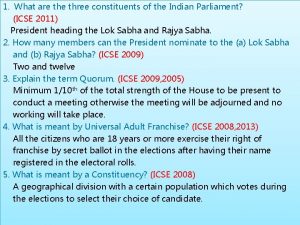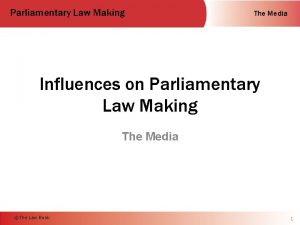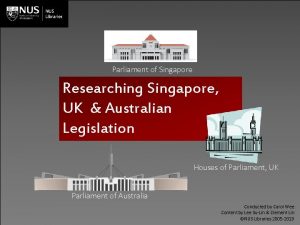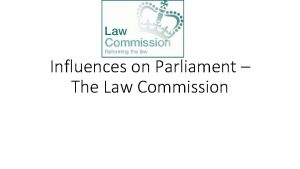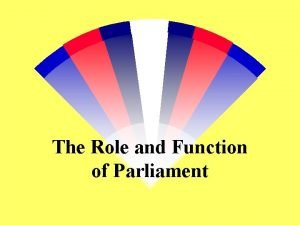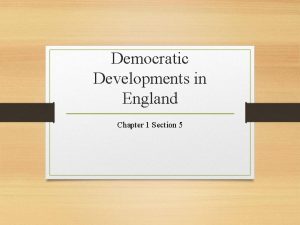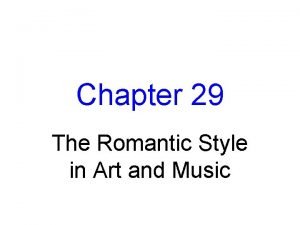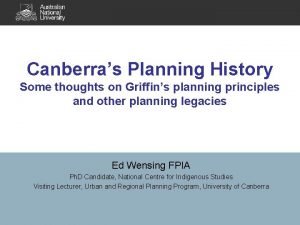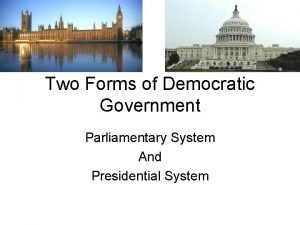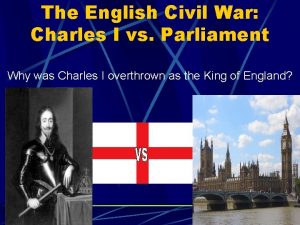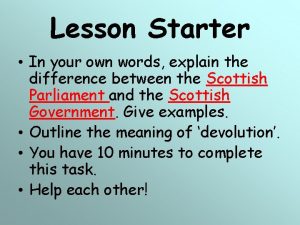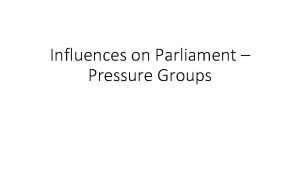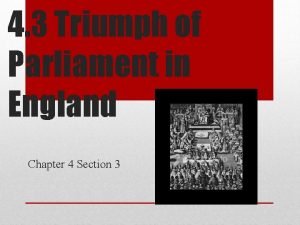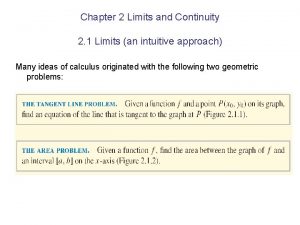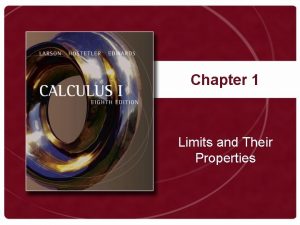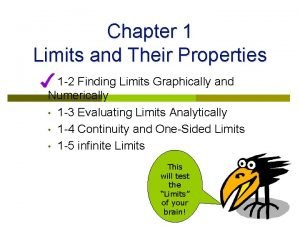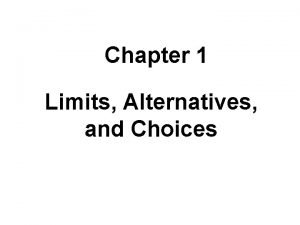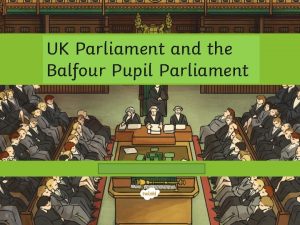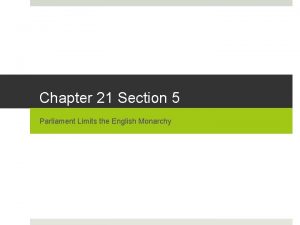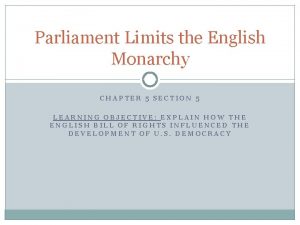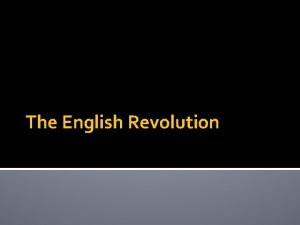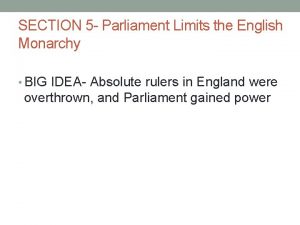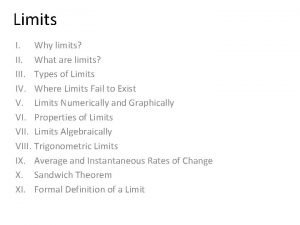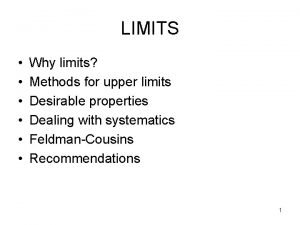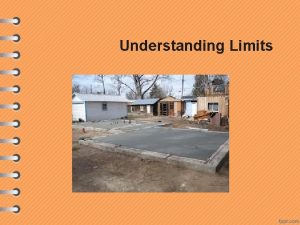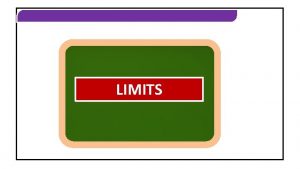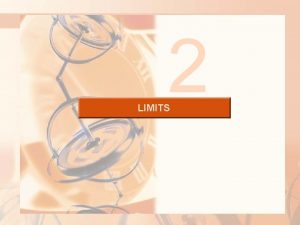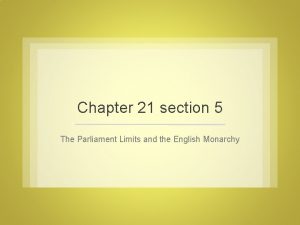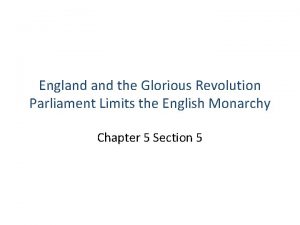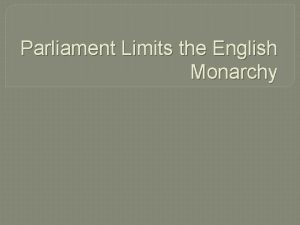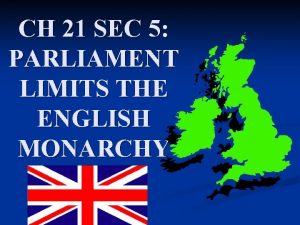Chapter Five Section Five Parliament Limits the English
















































- Slides: 48

Chapter Five- Section Five Parliament Limits the English Monarchy

The Earliest Political Cartoons = Nursery Rhymes At one time, it was quite dangerous to criticize the government. An offended king or queen would have your head removed from your shoulders. There was no freedom of speech, so those who did have complaints often hid them in happy little rhymes. The adults would make up silly little stories, using common people and common daily things, but those people and things stood for the nonsense that was going on at court. It was the only safe way to poke fun at the nobles. Those rhymes still exist today, but for the most part, we’ve forgotten their beginnings.

The Earliest Political Cartoons = Nursery Rhymes Georgie Porgie pudding and pie Kissed the girls and made them cry. When the boys came out to play Georgie Porgie ran away.

The Earliest Political Cartoons = Nursery Rhymes Georgie Porgie is believed to be about George Villiers, an English duke who lived in the early 1600 s. He was quite attractive and had very few morals, so he was always getting into romantic trouble. The common people loved to make fun of the nobles who couldn’t remember to whom they were married.

The Earliest Political Cartoons = Nursery Rhymes Humpty Dumpty sat on a wall. Humpty Dumpty had a great fall. All the king’s horses and all the king’s men Couldn’t put Humpty together again.

The Earliest Political Cartoons = Nursery Rhymes Humpty wasn’t an egg as is usually pictured, but a cannon used in an English civil war in 1648. The cannon was perched on a wall, but the wall crumbled under fire and the greatly feared weapon broke. The “king’s men, ” or the people loyal to the crown, lost that battle due to the loss of the cannon called Humpty Dumpty.

The Earliest Political Cartoons = Nursery Rhymes Little Jack Horner sat in a corner eating his Christmas pie. He stuck in his thumb and pulled out a plum and said, “What a good boy am I. ”

The Earliest Political Cartoons = Nursery Rhymes In the 1530 s, King Henry VIII, who had left the Roman Catholic Church, started breaking up the great monasteries of England taking their land riches. One monastery tried to bribe the king by sending him paperwork that gave him the titles to 12 large castles and pieces of land. The paperwork was hidden inside a pie. That was normal at the time because thieves were everywhere on the roads. The messenger was named Richard Whiting, not Jack Horner, but it is believed he stole the title to the best piece of land. The monastery was eventually destroyed, but that one piece of land was never retrieved, and Richard Whiting was never caught. He was a “good boy. ”

The Earliest Political Cartoons = Nursery Rhymes Mary, Mary quite contrary How does your garden grow? With silver bells and cockleshells And pretty maids in a row.

The Earliest Political Cartoons = Nursery Rhymes This one refers to Bloody Mary, the daughter of Henry VIII. She wanted to return England to the Roman Catholic Church and she had anyone who disagreed tortured or killed. The garden in the rhyme is really a graveyard. Silver bell was a nickname for a thumbscrew. Cockleshells were also an instrument of torture, but they were connected a bit lower than the thumb. A guillotine was commonly known as “the maid. ”

The Earliest Political Cartoons = Nursery Rhymes Following are elements necessary for a good, oldfashioned nursery rhyme: > it talks about a bit of history > it turns major players into common folk > the evilness or stupidity of subject’s actions are hidden but still understandable in a story that doesn’t seem as awful as what is really happening > it possesses a happy rhythm and rhyme that makes

Absolutism Objective Summarize the development of absolute and constitutional monarchies in Europe from 1500 to 1800

Chapters In Brief When Queen Elizabeth died, her cousin James, King of Scotland, became king of England. James fought with Parliament over money. His religious policies also angered the Puritans in Parliament. They wanted to reform the English church to rid it of Catholic practices. James was unwilling to make these changes. His son, Charles I, continued the tension between king and Parliament forced him to sign a Petition of Right in 1628. by signing, Charles allowed that the king was answerable to Parliament. Then he dissolved the Parliament and tried to raise money without it – going directly against the Petition of Right. Other actions of Charles had caused Scotland to threaten to invade England. To meet the danger, Charles needed some money, and to raise taxes he needed Parliament. When Charles called a new

Chapters In Brief Parliament, it quickly passed laws to limit his power. Charles responded by trying to arrest its leaders. Soon England was plunged into a civil war: Charles and his Royalists against the supporters of parliament, many of whom were Puritans. The English Civil War lasted from 1642 to 1649. Under the leadership of Oliver Cromwell, the forces of the Puritans won. They tried and executed Charles for treason – the first time a king had ever been executed in public. Cromwell became a military dictator, ruling until 1658. He crushed a rebellion in Ireland tried to reform society at home. Soon after his death, though, the government collapsed. The new Parliament asked Charles’s older son to restore the monarch. Charles II began to rule in 1660.

Chapters In Brief Charles II’s reign was a period of calm after turmoil. After his death in 1685, James II became king. His pro-Catholic policies angered and worried the English, who feared that he would restore Catholicism. Finally, in 1688, seven members of Parliament contacted James’s older daughter, Mary, and her husband, William of Orange, prince of the Netherlands – both Protestants. They wanted them to replace James II on the throne. The event was called the Glorious Revolution, a bloodless revolution that forced James to flee to France. William and Mary agreed, swearing to rule according to the laws made by Parliament. They agreed to accept the Bill of Rights, which guaranteed English people certain rights. From then on, no king or queen could rule England without the consent of Parliament.

Review of English Monarchs

Henry VIII (1509 - 1547) n n Act of Supremacy 6 Wives “Divorced, beheaded, divorced, beheaded, survived” 1. 2. 3. 4. 5. 6. Catherine of Aragon Anne Boelyn Jane Seymour Anne of Cleves Catherine Howard Catherine Parr

Henry VIII (1509 – 1547) n n n broke economic, spiritual and political ties with the Catholic Church built Royal Navy consulted with Parliament often when in need of, and Parliament passed new taxes avid gambler, dice player, and athlete (tennis, jousting, hunting)musician, author , and poet died of obesity, ulcerations, possibly Type II diabetes

Edward VI (1547 – 1553) n n n Regency Council young and weak abolished clerical celibacy and mass to firmly establish Protestantism economic and social unrest died at age 15

Mary I (Bloody Mary) 1553 - 1558 n n n n Catholic married to Philip II burned Protestants mother is Catherine of Aragon trade suffered drawn in to many Spanish wars lost Calais to French

Elizabeth (1558 – 1603) n n n n virgin Queen established Anglican Church refused Philip II did not outlaw piracy of Spanish ships defeated Spanish Armada executed Mary Queen of Scots (cousin) controlled but consulted with Parliament no Heir

Setting the Stage… n n n during her reign, Queen Elizabeth I of England had frequent conflicts with Parliament many of the arguments were over money $$$$ treasury did not have enough funds to pay the queen’s expenses Elizabeth I died in 1609 and left a huge debt for her successor to deal with Parliament’s financial power was one obstacle to English rulers’ becoming absolute monarchs the struggle between Parliament and the monarchy would have serious consequences for England

Monarchs Defy Parliament James I Elizabeth had no children – nearest relative was her cousin James Stuart (already King of Scotland) n 1603 - King James I of England n Scotland England united under one crown = shared a ruler n James I wanted absolute power when he inherited the throne from Queen Elizabeth n believes in divine right – will not share power n always conflict between the royalty and parliament over money n

James I (continued) n Royalty wants money for royal court and foreign wars n he annoyed people because he refused Puritan reforms n n get rid of Catholic practices known for the Puritan translation - King James Bible

Charles I n 1625: James I dies n his son, Charles I, gets the throne n always needed money for war with both Spain and France n when parliament denied money requests, he dissolved parliament

Charles I (continued) n 1628 - parliament gets back together and asks Charles to sign the Petition of Right n n n n No imprisonment without due cause No taxation without parliament’s consent No putting soldiers in private homes No martial law during peacetime Petition of Right set forth the idea that law was higher than the king Charles I signed the petition and then ignored it 1629 - dissolved parliament again and levied taxes on the people to get money

English Civil War History Frame Individual Activity Read page 181 in textbook n Fill out History Frame Organizer n Keep for your records – test questions will come from it

History Frame - Answers n Title: English Civil War n Participants / Key Players: n n King Charles I Oliver Cromwell Parliament Citizens of England n Problem or Goal: Parliament limits royal powers / civil war n When and Where: 1642 to 1649 in England

History Frame - Answers n Key Episodes of Events: n n n n 1642 – Charles tried to arrest Parliament’s leaders 1644 – Puritans find a winning general (Oliver Cromwell) 1647 – Cromwell held king as prisoner 1649 – Charles brought to trial for treason & be-headed 1649 – Cromwell in power and abolishes the monarchy and the House of Lords 1649 – Cromwell put down a rebellion in Ireland 1653 – Cromwell creates written constitution, tears it up, and becomes a military dictator

History Frame - Answers n Resolution or Outcome: n Cromwell and the Puritans reformed society n making laws that promoted Puritan morality n abolished activities they found sinful (theatre, sporting events, dancing) n Theme / Lesson / So what? n Answers will vary – what did you learn?

English Civil War n n n Charles I ruled over Scotland AND England there were several religions Charles I wanted ONE religion the Scots threatened Charles with a rebellion and civil war cost money - Charles needed Parliament did not like him and wanted to limit his power n n Supporters of Charles I = Royalists The opposition supports Parliament = Roundheads

More English Civil War n under leadership of Oliver Cromwell, the Puritan roundheads finally won (1646) n took Charles I hostage, tried him in front of the public, and executed him n the decapitation

Oliver Cromwell (1649 – 1661) 1649 - he got rid of the monarchy and established a republican form of government n sent most of Parliament home n n n established a military dictatorship Ireland, under English rule, revolted against Cromwell and failed

Puritan Morality n Cromwell and the Puritans sought to reform society wanted to improve England’s morality n abolished all “sinful” things (theater, sporting events, dancing) n n Cromwell was tolerant of other religions despite his deep Puritan belief n EXCEPT Catholics

Charles II (1661 – 1685) n 1658 – Oliver Cromwell dies n English ask the oldest son of Charles I to rule England n 1661 – Charles II begins reign n restored the monarch = restoration n allowed the return of theater and sports

Restoration and Revolution n Parliament passed important guarantee of freedom = Habeas Corpus n n n “to have the body” people need to know why they’re arrested could not be held indefinitely without trial

Restoration and Revolution n n n Charles has no heir; brother is James 1685 Charles II died James II inherited the throne Whigs opposed / Tories supported The first two political parties in England were the Whigs and Tories nobody liked James II n n he was flamboyantly Catholic gave his Catholic friends good jobs

James II (1685 – 1689) n 1688 – James’s second wife gave birth to a son; English Protestants became terrified at the prospect of Catholic kings n James’s daughter, Mary, was Protestant n James II was peacefully overthrown by his own daughter (Mary) and her husband (William of Orange – prince of the Netherlands Glorious Revolution: bloodless overthrow of King James II

Limits on Monarch’s Power n n n William and Mary become rulers William and Mary recognize Parliament as their partner in governing create a constitutional monarchy ** Constitutional Monarchy: laws limited the ruler’s power ** n 1689 - Bill of Rights (make clear limits of royal power) n n No stopping Parliament’s laws No taxes without Parliament’s consent Freedom of speech in Parliament No penalty for complaining about the King

William and Mary (1689 – 1702) ** William and Mary were the rulers that came to power under the agreement that they will rule as a constitutional monarchs by following the English Bill of Rights **

Cabinet System Develops n established a cabinet n n cabinet was a link between the majority party in Parliament and the King became center of power and policymaking n n still exists today leader of cabinet = Prime Minister

Additional English Monarchs

Anne Stuart 1702 -1714 n n n inherited throne when William passed sister-in-law to William Act of Union n n Scotland England united as Great Britain cabinet formed

George I (1714 – 1727) n founded the position of Prime Minister

George II (1727 – 1760) n Officially established the Constitutional Monarchy

George III (1760 – 1820) n gained land in North America after French and Indian War against France n War debt = n taxes = n rebellion of colonies = n American Revolution

Essential Question Explain the difference of a constitutional monarch and an absolute monarchy. Answer the question in three complete sentences in your summary section.

Absolutism Objective Summarize the development of absolute and constitutional monarchies in Europe from 1500 to 1800
 Chapter 5 section 5 parliament limits the english monarchy
Chapter 5 section 5 parliament limits the english monarchy Parliament limits the english monarchy chapter 5 section 5
Parliament limits the english monarchy chapter 5 section 5 Parliament limits the english monarchy answer key
Parliament limits the english monarchy answer key Parliament limits the english monarchy
Parliament limits the english monarchy Parliament limits the english monarchy
Parliament limits the english monarchy Parliament limits the english monarchy
Parliament limits the english monarchy Horizontal
Horizontal Real limits vs. apparent limits
Real limits vs. apparent limits Chapter 19 section 2 china limits european contacts
Chapter 19 section 2 china limits european contacts How did hongwu bring stability to china
How did hongwu bring stability to china What is an example of a density independent limiting factor
What is an example of a density independent limiting factor The british parliament sits in
The british parliament sits in European parliament voter turnout
European parliament voter turnout Gdailymail
Gdailymail Venn diagram of parliamentary and presidential
Venn diagram of parliamentary and presidential Advantages and disadvantages of rules and regulations
Advantages and disadvantages of rules and regulations What are the three constituents of the indian parliament
What are the three constituents of the indian parliament Disadvantages of media influence on parliament
Disadvantages of media influence on parliament Parliament
Parliament Law commission influence on parliament
Law commission influence on parliament Role of parliament
Role of parliament Parliament
Parliament How did parliament emerged victorious in medieval england
How did parliament emerged victorious in medieval england Houses of parliament architecture style
Houses of parliament architecture style Parliament house
Parliament house Definition of presidential form of government
Definition of presidential form of government Frankfurt parliament
Frankfurt parliament Write a note on frankfurt parliament
Write a note on frankfurt parliament European parliament legal affairs committee
European parliament legal affairs committee Charles 1 vs parliament
Charles 1 vs parliament Founding principles of the scottish parliament
Founding principles of the scottish parliament Influences on parliament
Influences on parliament Lesson 3 triumph of parliament in england
Lesson 3 triumph of parliament in england Limits
Limits Limits and their properties
Limits and their properties Chapter 1 limits and their properties
Chapter 1 limits and their properties Trig limits
Trig limits Economizing problem definition
Economizing problem definition Study guide chapter 10 section 1 meiosis
Study guide chapter 10 section 1 meiosis Hát kết hợp bộ gõ cơ thể
Hát kết hợp bộ gõ cơ thể Lp html
Lp html Bổ thể
Bổ thể Tỉ lệ cơ thể trẻ em
Tỉ lệ cơ thể trẻ em Chó sói
Chó sói Tư thế worm breton
Tư thế worm breton Hát lên người ơi
Hát lên người ơi Môn thể thao bắt đầu bằng từ chạy
Môn thể thao bắt đầu bằng từ chạy Thế nào là hệ số cao nhất
Thế nào là hệ số cao nhất Các châu lục và đại dương trên thế giới
Các châu lục và đại dương trên thế giới
